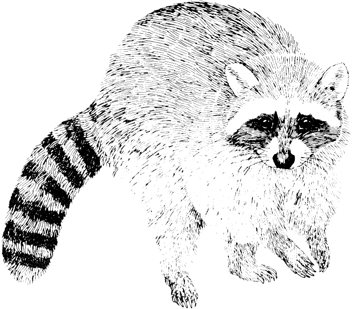
Raccoon
Distribution, Abundance, and Seasonality
Widespread, common to uncommon permanent resident throughout most of the state. Occurs in all habitats except alpine, and desert types without water; marginal in Great Basin shrub types. Most abundant in riparian and wetland areas at low to middle elevations (Grinnell et al. 1937).

Range Map
Specific Habitat Requirements
Feeding: Raccoons are omnivorous, and highly opportunistic. In spring, eat primarily animal matter; crayfish, fish, arthropods, amphibians, a few small mammals, birds, and eggs. In summer and fall, eat large amounts of grains, acorns, other nuts, and fruits. Forage along all saline and freshwater riparian habitats, in shallow water, in vegetation, and on the ground. Frequently feed in agricultural and urban areas.
Cover: Raccoons use cavities in trees, snags, logs, and rocky areas for dens and other cover. Also use cover provided by abandoned buildings and dense vegetation. Use dens, and, especially in mild weather, use daily nest sites.
Reproduction: Nest in secure dens. Tree dens generally are 6.1 to 12.2 m (20 to 40 ft) above the ground.
Water: Permanent water is necessary for drinking and feeding. Closely associated with water.
Pattern: The juxtaposition of riparian habitats and other wetlands, and forest and shrubland types is important to raccoon populations.
Species Life History
Activity Patterns: Nocturnal. Remain dormant in winter dens (Lotze and Anderson 1979).
Seasonal Movements / Migration: Non-migratory.
Home Range: Ellis (1964) found home ranges averaging 225 ha (555 ac), and varying from 85-380 ha (210-940 ac). In Michigan, home ranges of males averaged 204 ha (503 ac), and varied from 18.2-814 ha (45-2021 ac). Home ranges of females averaged 108 ha (268 ac), and varied from 5.3-376 ha (13-9330 ac) (Stuewer 1943). In North Dakota, home ranges of males varied from 396-1468 ha (979-3627 ac), and from 532 to 743 ha (1315-1836 ac) for females (Fritzell 1977). Pregnant females have larger home ranges, which may vary considerably. Lotze and Anderson (1979) reported population densities of 1 raccoon per 5-43 ha (12-106 ac).
Territory: Radiotelemetry studies suggest that male raccoons may be territorial towards other males, but that females are not territorial (Lotze and Anderson 1979).
Reproduction: In California, raccoons breed fror January through March. Females ovulate spontaneously (Sanderson and Nalbandov 1973). Most young are born March through May. Litters average 3-4, and range from 1-8. Gestation lasts about 63 days (range = 54-65 days). Young weaned at 60-90 days, and become semi-independent at about 130 days. Males and females begin breeding in first or second yr (Lotze and Anderson 1979).
Niche: Raccoons are very adaptable, and tolerant of most human activity. May be pests when they prey on domestic animals, or consume cultivated fruits, vegetables, and other crops. Great horned owls, bobcats, and domestic dogs prey on raccoons. Diseases carried include trichinosis, rabies, leptospirosis, tularemia, and Chagas' disease. Canine distemper is an important mortality factor, especially among young (Johnson 1970).
Sources & References
California Department of Fish and Game, 1999.
California's Wildlife, Sacramento, CA.
Written by: G. Ahlborn, reviewed by: M. White, edited by: M. White, G. Ahlborn
Asdell, S. A. 1964. Patterns of mammalian reproduction. 2nd ed. Cornell Univ. Press, Ithaca, Ny. 670pp. Ellis, R. J. 1964. Tracking raccoons by radio. J. Wildl. Manage. 28:363-368. Fritzell, E. K. 1977. Dissolution of raccoon sibling bonds. J. Mammal. 58:427-428. Grinnell, J., J. S. Dixon, and J. M. Linsdale. 1937. Fur-bearing mammals of California. 2 Vols. Univ. California Press, Berkeley. 777pp. Johnson, A. S. 1970. Biology of the raccoon (Procyon lotor varius) in Alabama. Auburn Univ. Agric. Exp. Sta. Bull. No. 402. 148pp. Lotze, J. H., and S. Anderson. 1979. Procyon lotor. Mammal. Species No. 119. 8pp. Newberry, D. W. 1973a. A contribution towards a bibliography of California furbearers. Calif. Dept. Fish and Game, Spec. Wildl. Invest., Sacramento. 148pp. Rue, L. L. 1964. The world of the raccoon. J. B. Lippincott, New York. 145pp. Sanderson, G. C., and A. V. Nalbandov. 1973. The reproductive cycles of the raccoon in Illinois. III. Nat. Hist. Surv. Bull. 31:25-85. Stuewer, F. W. 1943. Raccoons: Their habits and management in Michigan. Ecol. Monogr. 13:203-257. Urban, D. 1970. Raccoon populations, movement patterns, and predation on a managed waterfowl marsh. J. Wildl. Manage. 34:372-382.
California Animal Facts | California's Wildlife